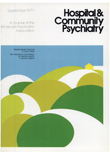Three Utilization Styles at an Urban Mental Health Center
Abstract
The authors report a study of utilization of services based on data obtained on two patient groups at an urban mental health center: a one-year applicant population, consisting of an unduplicated count of all adults applying for psychiatric care during a one-year period; and a one-day prevalence population, consisting of all persons on a psychiatric roster on a single selected day. Juxtaposing diagnosis, applicant-to-prevalence ratios, and treatment or services used, they found three styles of utilization of services—the intensive user, as exemplified by the neurotic in psychotherapy, the casual user (the schizophrenic attending medication clinic), and the pseudo user (the alcoholic using detoxification services). The intensive user represents a minority utilization style, while the last two styles are predominant at the center. Taken together they characterize the typical patient as a therapeutically passive user of services.
Access content
To read the fulltext, please use one of the options below to sign in or purchase access.- Personal login
- Institutional Login
- Sign in via OpenAthens
- Register for access
-
Please login/register if you wish to pair your device and check access availability.
Not a subscriber?
PsychiatryOnline subscription options offer access to the DSM-5 library, books, journals, CME, and patient resources. This all-in-one virtual library provides psychiatrists and mental health professionals with key resources for diagnosis, treatment, research, and professional development.
Need more help? PsychiatryOnline Customer Service may be reached by emailing [email protected] or by calling 800-368-5777 (in the U.S.) or 703-907-7322 (outside the U.S.).



